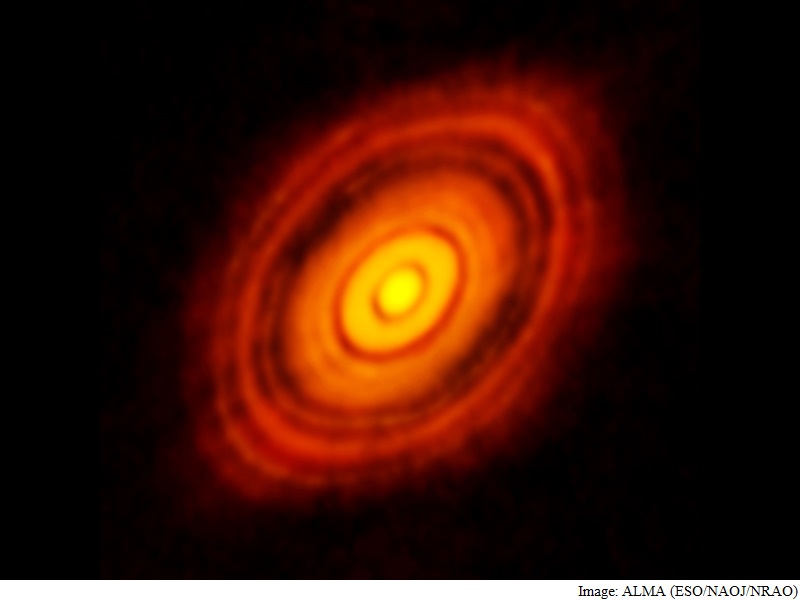- Home
- Science
- Science News
- Evidence of Baby Planets Spotted Around Young Star: Study
Evidence of Baby Planets Spotted Around Young Star: Study

In November 2014, Atacama Large Millimetre/submillimetre Array (ALMA) in Chile released a startling image of a young star HL Tauri and its dust disk.
The image, sharpest ever taken for this kind of object, depicts several gaps in the dust disk around the star. Since the disks are sites of planet formation, researchers suggest that the dark gaps are carved by infant planets forming in the disk that sweep away dust along their orbits.
However, HL Tauri is very young, estimated to be only about a million years, and classical studies indicate that it takes more than tens of millions of years for planets to form from small dust.
Some researchers propose other mechanisms to form gaps: changes in the dust size through coalescence or destruction; or the formation of dust due to gas molecules freezing.
Disks around young stars contain gas in addition to the dust. In general the amount of gas is 100 times larger than that of dust.
Researchers, including those from Kagoshima University in Japan, focused on the distribution of gas in the disk to better understand its true nature. If the dust gaps are caused by the variance of the dust properties, that would not directly affect the gas, so no gaps would be seen in the gas distribution.
If on the other hand, the gaps in the dust are caused by the gravity of forming planets, the gravity would be expected to create gaps in the gas as well. The team extracted the emissions from gas molecules in 2014 ALMA Long Baseline Campaign data and summed up the emissions in rings around the star.
The image of the gas distribution unveils at least two gaps in the disk, at the radii of 28 and 69 astronomical units.
"To our surprise, these gaps in the gas overlap with the dust gaps," said Hsi-Wei Yen from Academia Sinica Institute of Astronomy and Astrophysics in Taiwan.
"This supports the idea that the gaps are the footprints left by baby planets," Yen said. The fact that the gaps in the dust and the gas match-up implies that the amount of material in the gaps likely decreases. This disfavours some of the theories that tried to explain the gaps solely by changes in the dust particles. A decrease in the amount of material in the gaps supports the planet formation theory, in spite of HL Tauri's young age.
"Our results indicate that planets start to form much earlier than what we expected," Yen said. The team also found that the gas density is high enough to harbour an infant planet around the inner gap. Comparing the structure of the inner gap to theoretical models, the team estimates the planet has a mass 0.8 times that of Jupiter. The study was published in the Astrophysical Journal Letters.
Catch the latest from the Consumer Electronics Show on Gadgets 360, at our CES 2026 hub.
Related Stories
- Samsung Galaxy Unpacked 2025
- ChatGPT
- Redmi Note 14 Pro+
- iPhone 16
- Apple Vision Pro
- Oneplus 12
- OnePlus Nord CE 3 Lite 5G
- iPhone 13
- Xiaomi 14 Pro
- Oppo Find N3
- Tecno Spark Go (2023)
- Realme V30
- Best Phones Under 25000
- Samsung Galaxy S24 Series
- Cryptocurrency
- iQoo 12
- Samsung Galaxy S24 Ultra
- Giottus
- Samsung Galaxy Z Flip 5
- Apple 'Scary Fast'
- Housefull 5
- GoPro Hero 12 Black Review
- Invincible Season 2
- JioGlass
- HD Ready TV
- Laptop Under 50000
- Smartwatch Under 10000
- Latest Mobile Phones
- Compare Phones
- OPPO Reno 15 FS
- Red Magic 11 Air
- Honor Magic 8 RSR Porsche Design
- Honor Magic 8 Pro Air
- Infinix Note Edge
- Lava Blaze Duo 3
- Tecno Spark Go 3
- iQOO Z11 Turbo
- Lenovo Yoga Slim 7x (2025)
- Lenovo Yoga Slim 7a
- Lenovo Idea Tab Plus
- Realme Pad 3
- Moto Watch
- Garmin Quatix 8 Pro
- Haier H5E Series
- Acerpure Nitro Z Series 100-inch QLED TV
- Asus ROG Ally
- Nintendo Switch Lite
- Haier 1.6 Ton 5 Star Inverter Split AC (HSU19G-MZAID5BN-INV)
- Haier 1.6 Ton 5 Star Inverter Split AC (HSU19G-MZAIM5BN-INV)







![[Sponsored] Haier C90 OLED TV | Dolby Vision IQ, 144Hz OLED and Google TV in Action](https://www.gadgets360.com/static/mobile/images/spacer.png)









